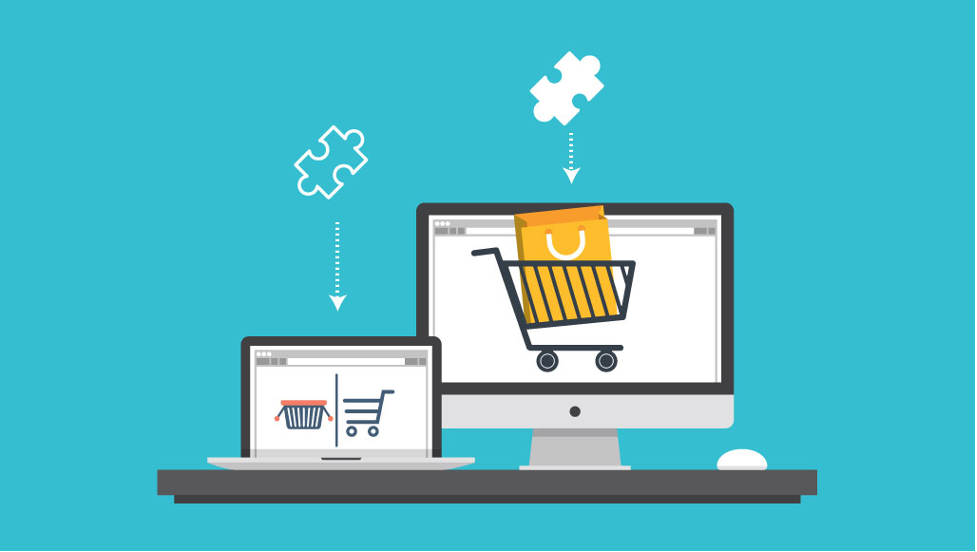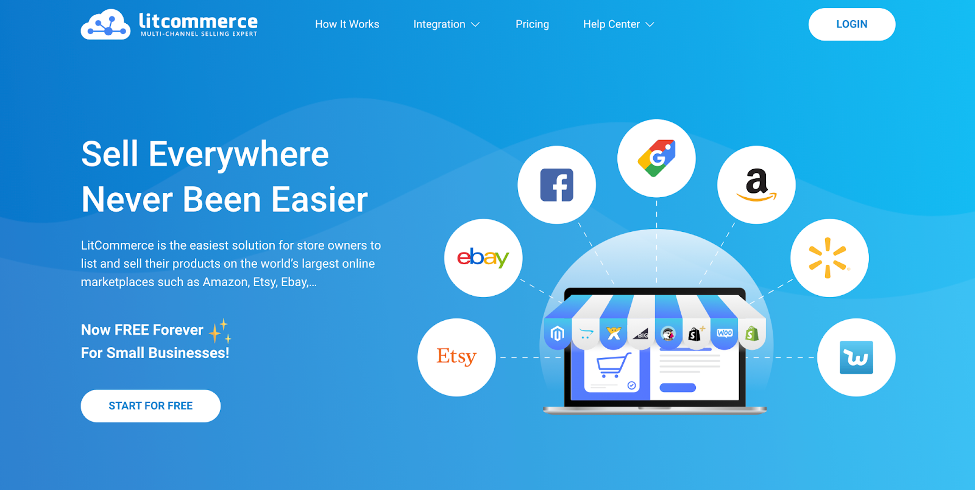Let’s imagine you are aggressively growing your eCommerce business and it’s becoming harder to manage. The mass volume of orders, customers, and inventory makes it too overwhelming for you to handle. In such cases, you may probably need eCommerce integration of your website with other solutions to effectively monitor and improve your business performance.
You should consider all of the eCommerce integrations on which your growth strategy is based. It’s always a good time to find out if your business is ready for integration and how to get started with it.
This article will provide you with:
- What is eCommerce integration?
- What are the benefits?
- Signs you need eCommerce integration and how to prepare.
- Our recommendation on the multi-channel selling solutions.
Let’s go!
What is eCommerce Integration?
eCommerce integration is known as the synchronization of your eCommerce website with other systems, such as an ERP (Enterprise resource planning) or CRM (Customer relationship management) system.

For example, it’s necessary for merchants to constantly keep track of the inventory status. Also, modifying the inventory count when they sell an item online is a must, too. Without integration, they need to manually update any changes of the orders, products, customers in both systems to reflect the proper numbers.
By starting an eCommerce integration with an ERP, wholesalers, manufacturers, and other retailers can create bidirectional flows of information between the two systems. This allows them to enter data into one system only and still get up-to-date information on both their store and the ERP.
Furthermore, eCommerce integration can help you expand your reach to a much wider audience, automate your inventory update along with real-time synchronization between channels. Thus, it’ll be much more simple and convenient to effectively manage your business.
That is where the value of a well-implemented eCommerce integration lies. This approach avoids the need to manually enter the same data into multiple systems and helps streamline the overall management process.
3 Types of eCommerce integration
Currently, there’re 3 types of eCommerce integration that help you easily manage among systems. It is critical to select the method that is most aligned with long-term corporate objectives. Your method will be determined by the process, objectives, and development resources.
- Real-time (API) is a typical way to connect 2 systems in real-time via the Application Programming Interface (API). The API technique eliminates the need to manually match system data by automatically pushing data between the application and the eCommerce environment. Real-time integrations can be one-way or two-way, depending on your needs.
- Scheduled (SFTP or API) is a great option if you work with different suppliers, not all might sync their product catalogs the same. Especially, some scheduled activities such as updating invoicing and fulfillment information can be completed during non-peak hours. You should pay attention to customization options whether you use a scheduled SFTP or API method.
- Manual (CSV file upload) is the method that manages data to or from your website. It allows you to push individual files in the desired direction without incurring additional setup, integration, or development costs. A versatile eCommerce import and export engine are necessary in this case.
5+ Benefits of eCommerce Integration
As more businesses embrace online sales and brick-and-mortar storefronts become less dominant, the demand for eCommerce integration has skyrocketed. These 5 advantages of integrating business systems could be a good explanation for the increasing trend.
- Elimination of manual order entry: By integrating Magento, Shopify, Amazon, or other platforms with ERP systems, businesses may avoid manual and repeated data entry while improving data exchange speed. Data input by hand is totally inefficient and time-consuming, just so you know. Therefore, strengthening this procedure with a new eCommerce integration should increase overall efficiency.
- Accurate data and inventory levels: The accuracy of data is never left to chance with eCommerce integration. The fact is that manual data entry can always be subject to error no matter what. Accordingly, inventory synchronization and a real-time update will improve the accuracy of data exchange.
- Automatic notifications for customers: Automatic notifications for customers are becoming simple when your eCommerce applications and all back-end systems are in sync. Customers will receive timely notifications and track their order status easily.
- Uniform pricing: With only one update required, pricing changes and sales updates on all systems are quick and convenient with eCommerce integration.
- Opportunity to grow your brand through multiple marketplaces: eCommerce integration allows your company to expand into more online marketplaces while maintaining operational efficiency and consistency. The more marketplaces being integrated, the more customers you can reach out to.

Besides bringing certain benefits to your business, eCommerce integration also helps your customers experience better while improving operational efficiency:
- When displaying your products through multi-channel, your customers will see all the product’s information is accurate and consistent.
- Providing exact inventory counts can help customers notice that these products are in stock and ready to ship.
- Customers will be allowed to track the delivery status of their orders.
- The process of returning will be handled with ease and efficiency.
Signs that you need eCommerce integration and how to prepare for it
If you have a whole team spending the majority of their time manually moving data across systems, you’re ready for eCommerce integration. To be honest, whether it’s eCommerce orders, inventory counts, or product information updates, your staff shouldn’t have to spend hours moving the same data from one system to another.
When the same data is re-entered over again, mistakes are inevitable. A single blunder might result in inaccurate inventory counts, misspelled mailing addresses, or incorrect product information. Also, keep in mind that these issues aren’t exclusive to your team. Your customer experience may suffer as a result of a slow, error-prone manual process. Without eCommerce integration, you may also oversell if your inventory isn’t updated quickly enough.
How frequently does this error occur to your company? If it happens often, it’s time to think about integration.
Because integrating two business systems appears to be complicated, many companies postpone these initiatives to avoid disruptions. They also don’t want to be saddled with projects that take too long, go over budget, or just don’t work well.
With good planning and preparation, you may avoid these and other errors in your eCommerce website integration process. The following practices will come in handy when integrating your system:
- Determine which processes are manual and prone to errors. Integrations should take down these time-consuming and inefficient stages so that team members can focus on higher-value tasks.
- Decide what needs to be incorporated. For products, this can be inventory, cost, and descriptions. For customers, you should also include orders and shipping information. Some certain companies also require punch-out integrations, connectivity with external databases, or third-party logistics systems.
- Consider how information is exchanged between systems. Examine your ERP’s data routing, CRM’s customer data management, and accounting system’s payment processing.
- Take a look at the customer shopping experience and see where you can cut down on complexity. To do that, examine your buyers and their behaviors that could benefit from eCommerce integration.
- Select the most suitable integration strategy for your needs. Whether it’s done manually, on a timetable, or through an API. Your strategy should be able to meet not only your current but also your future needs.
Expanding your sales channels
Expanding sales channels is a good application of eCommerce integration among a variety of business models and sizes. A good system should be able to help completely automate your listing process, with precision and timeliness. It should also provide synchronization to streamline your operation and management procedures no matter how many channels you sell on.
Whether you’re just planning or already listed on marketplaces, LitCommerce is the recommended integration system to help you efficiently sell on multiple channels such as Etsy and eBay at the same time. The integration tool facilitates the process of expanding your business by synchronizing the database of all channels, allowing you to list products everywhere and manage everything from one dashboard.

Why choose LitCommerce?
- LitCommerce provides a cutting-edge integration solution at the most affordable price. You can easily sell your products on world-leading marketplaces.
- To eliminate human intervention, all integration stages are simplified as much as possible. With LitCommerce, you can have a hand-free integration experience with ease.
- Your store is active normally during the integration process which means no sales disruption!
- You can get access to a super dedicated support team through ticket, phone, live chat, and email. They are always there to help you 24/7, including holidays.
- 3 months of full-featured free trial helps you decide whether it’s worth using in the long run. You also have the option to upgrade or cancel your plan at any time.
Ecommerce integration: FAQs
Is there any possible problem with eCommerce integration?
Integrating with another system means that your data will be open to access. Security is always a priority when it comes to the online world, so it’s of utmost importance that you carefully choose a system that has credibility and is rated good by the community.
What is the biggest challenge I will face if I integrate my store with other systems?
Integration brings more benefits than harm. However, there’re a few things you may encounter when starting to integrate with a new system. First, the learning curve may be a bit steep in the beginning. You will have to spend some time learning how the new system works and how you can make the best use of it to facilitate your workflow. Second, if your business is small, pricing should also be a concern. Your revenue will not increase right as soon as you pay for the new system. In this case, carefully choose a pricing plan that you can handle, and consider this a long-term investment for your business. Besides, eCommerce software development entails building programs that let online retailers run their operations. This includes creating online shops, managing payments and inventory, processing orders, offering customer support resources, and coordinating with other programs, such as CRMs or shipping services.
Final Words
In a nutshell, eCommerce integration has a significant impact on daily operations and eCommerce performance. If an eCommerce integration decision makes sense for your company, don’t be afraid to spend the money to go for it; the long-term rewards are well worth it.
For further information, please don’t hesitate to contact our support team, we’re always pleased to help you to grow and scale the online business effectively.